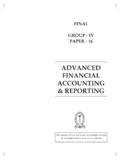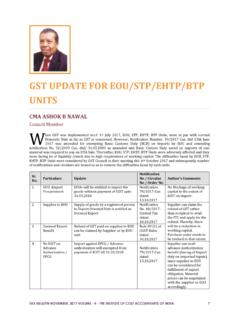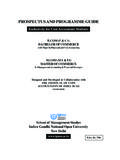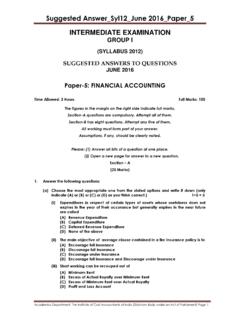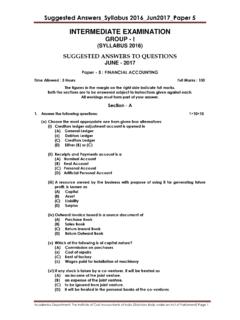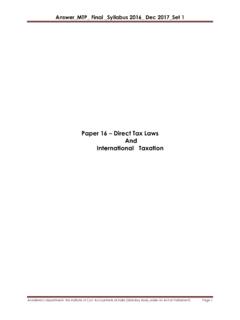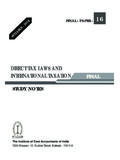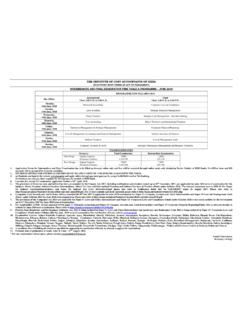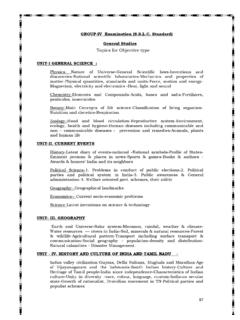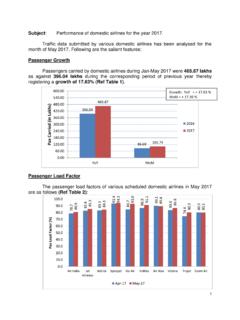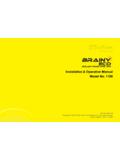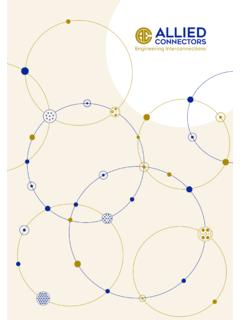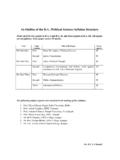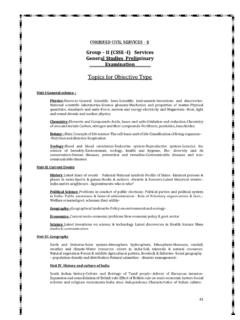Transcription of GOODS AND SERVICES TAX
1 GOODS AND SERVICES TAX 1 Introduction to GOODS and SERVICES TaxGST and Centre-State Financial RelationsConstitution (One Hundred and First) Amendment Act, 2016 GOODS and SERVICES Tax Council (GSTC) salient features of GSTB enefits of GSTG oods and SERVICES Tax NetworkTax RatesGoods and SERVICES Tax - Key ConceptsGOODS AND SERVICES TAX - AN INTRODUCTION INTRODUCTION TO GOODS AND SERVICES TAXThe introduction of GOODS and SERVICES Tax (GST) is a very significant step in the field of indirect tax reforms in India. By amalgamating a large number of Central and State taxes into a single tax, it has mitigated cascading or double taxation in a major way and paved the way for a common national market.
2 From the consumer point of view, the biggest advantage would be in terms of a reduction in the overall tax burden on GOODS or SERVICES , which was estimated to be around 25%-30%. Introduction of GST would also make Indian products competitive in the domestic and international markets. Studies show that this would have a boosting impact on economic growth. Because of its transparent and self-policing character, GST would be easier to idea of moving towards the GST was first mooted by the then Union Finance Minister in his Budget for 2006-07. Initially, it was proposed that GST would be introduced from 1st April, 2010. The Empowered Committee of State Finance Ministers (EC) which had formulated the design of State VAT was requested to come up with a roadmap and structure for the GST.
3 Joint Working Groups of officials having representatives of the States as well as the Centre were set up to examine various aspects of the GST and draw up reports specifically on exemptions and thresholds, taxation of SERVICES and taxation of inter-State supplies. Based on discussions within and between it and the Central Government, the EC released its First Discussion Paper (FDP) on GST in November, 2009. This spells out the features of the proposed GST and has formed the basis for discussion between the Centre and the States so far. GST AND CENTRE-STATE FINANCIAL RELATIONSB efore GST regime, fiscal powers between the Centre and the States were clearly demarcated in the Constitution with almost no overlap between the respective domains.
4 The Centre had the powers to levy tax on the manufacture of GOODS (except alcoholic liquor for human consumption, opium, narcotics etc.) while the States had the powers to levy tax on sale of GOODS . In case of inter-State sales, the Centre had the power to levy a tax (the Central Sales Tax) but, the tax was collected and retained entirely by the originating States. As for SERVICES , it was the Centre alone that was empowered to levy GOODS and SERVICES Tax - An Introduction2 service tax. Since the States were not empowered to levy any tax on the sale or purchase of GOODS in the course of their importation into or exportation from India, the Centre levied and collected this tax as additional duties of customs, which was in addition to the Basic Customs Duty.
5 This additional duty of customs {commonly known as Counter Veiling Duty (CVD) and Special Additional Duty (SAD)} counter balances excise duties, sales tax, State VAT and other taxes levied on the like domestic product. Introduction of GST was requiring amendments in the Constitution so as to concurrently empower the Centre and the States to levy and collect the assignment of concurrent jurisdiction to the Centre and the States for the levy of GST required a unique institutional mechanism that would have ensured that decisions about the structure, design and operation of GST are taken jointly by the two. For it to be effective, such a mechanism also needed to have Constitutional force.
6 CONSTITUTION (ONE HUNDRED AND FIRST) AMENDMENT ACT, 2016To address all these and other issues, the Constitution (122nd Amendment) Bill was introduced in the 16th Lok Sabha on The Bill provided for a levy of GST on supply of all GOODS or SERVICES except for Alcohol for human consumption. The tax shall be levied as Dual GST separately but concurrently by the Union (central tax - CGST) and the States [including Union Territories with legislatures) (State tax - SGST)/ Union territories without legislatures (Union territory tax- UTGST)]. The Parliament would have exclusive power to levy GST (integrated tax - IGST) on inter-State trade or commerce (including imports) in GOODS or SERVICES .
7 The Central Government will have the power to levy excise duty in addition to the GST on tobacco and tobacco products. The tax on supply of five specified petroleum products namely crude, high speed diesel, petrol, Aviation Turbine Fuel (ATF) and natural gas would be levied from a later date on the recommendation of GST GOODS and SERVICES Tax Council (GSTC) shall be constituted comprising the Union Finance Minister, the Minister of State (Revenue) and the State Finance Ministers to recommend on the GST rate, exemption and thresholds, taxes to be subsumed and other features. This mechanism would ensure some degree of harmonization on different aspects of GST between the Centre and the States as well as across States.
8 One half of the total number of members of GSTC would form quorum in meetings of GSTC. Decision in GSTC would be taken by a majority of not less than three-fourth of weighted votes cast. Centre and minimum of 20 States would be required for majority because Centre would have one-third weightage of the total votes cast and all the States taken together would have two-third of weightage of the total votes Constitution Amendment Bill was passed by the Lok Sabha in May, 2015. The Bill was referred to the Select Committee of Rajya Sabha on The Select Committee had submitted its Report on the Bill on The Bill with certain amendments was finally passed in the Rajya Sabha and thereafter by Lok Sabha in August, 2016.
9 Further the bill had been ratified by required number of States and received assent of the President on 8th September, 2016 and has since been enacted as Constitution (101st Amendment) Act, 2016 16th September, 2016. 3 GOODS AND SERVICES TAX COUNCIL (GSTC)The GSTC has been notified with effect from 12th September, 2016. GSTC is being assisted by a Secretariat. The following major decisions have been taken by the GSTC in different meetings held by them:(i) The threshold exemption limit would be ` 20 lakh. For special category States enumerated in article 279A of the Constitution, threshold exemption limit has been fixed at ` 10 lakh.
10 (ii) Composition threshold shall be ` 75 lakh. Composition scheme shall not be available to inter-State suppliers, service providers (except restaurant service) and specified category of manufacturers.(iii) Existing tax incentive schemes of central or state governments may be continued by respective government by way of reimbursement through budgetary route. (iv) There would be four major tax rates namely 5%, 12%, 18% and 28%. The tax rates for different GOODS and SERVICES have been finalized. Besides, some GOODS and SERVICES would be under the list of exempt items. The exempted SERVICES has been finalized, except SERVICES supplied by GOODS and SERVICES Tax Network which is the addition to the list of exempted SERVICES under service tax regime.
